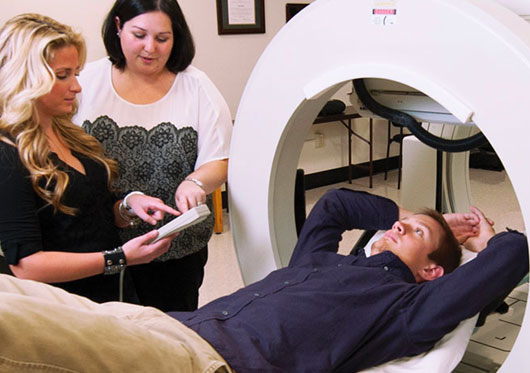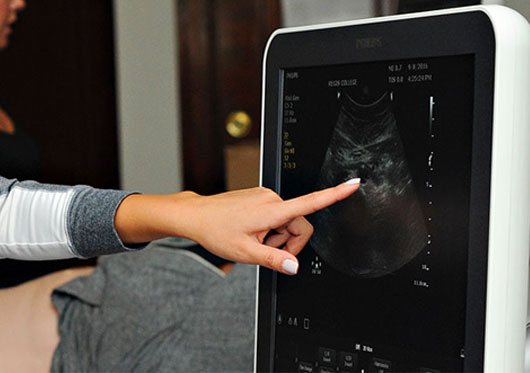If you’re interested in a high-demand healthcare career that offers advanced technology and strong earning potential, consider the medical imaging industry. Rapid advancements in diagnostic technology are driving this field’s growth, creating more opportunities for skilled professionals like you. And while a two-year degree can help you get started, obtaining a four-year degree can lead to higher salaries, leadership positions, and specialized opportunities.
Key Takeaways
- A career in medical imaging offers a dynamic and high-demand path in healthcare, with opportunities to work with cutting-edge diagnostic technology.
- High-paying medical imaging careers include nuclear medicine technologists, MRI technologists, and diagnostic medical sonographers, with annual salaries ranging from $61,901 to $79,602.
- A four-year bachelor’s degree provides access to higher salaries, leadership positions, and specialized career paths.
- Employers increasingly prefer candidates with a bachelor’s degree because it equips professionals with advanced technical skills, regulatory knowledge, and leadership training.
- The future of medical imaging is evolving with AI-driven diagnostics, mobile imaging, and precision medicine.
Is medical imaging a good career?
Medical imaging is an excellent career choice for those interested in healthcare, technology, and patient care. This field offers strong job stability, driven by the growing demand for diagnostic imaging in hospitals, outpatient centers, and specialized clinics. According to the U.S. Bureau of Labor Statistics, employment for radiologic and MRI technologists is projected to grow six percent by 2032, keeping pace with the overall expansion of healthcare professions. This growth is largely fueled by the aging population and the increasing need for early disease detection, making medical imaging a reliable and essential career path.
Beyond stability, medical imaging provides ample career growth and innovation. Professionals in this field work with advanced imaging technologies such as MRI, ultrasound, and nuclear medicine. In addition, AI-driven imaging advancements, such as computer-aided detection for early cancer diagnosis and deep-learning algorithms are enhancing image quality and interpretation, which can help reduce repetitive tasks and allow imaging professionals to focus on complex cases and pursue specialized roles in areas like interventional radiology, cardiac imaging, and pediatric sonography.

Source: Lightcast 2022
Five High-Paying Medical Imaging Jobs
As physicians find new ways to study and treat the human body, there’s a greater demand for technicians trained in diagnostic imaging procedures. However, medical imaging starting salaries can vary according to factors like job requirements or mandatory specialized training. It’s important to determine which jobs in medical imaging are right for you.
To identify which career aligns with your professional and personal goals, it is important to know the types of medical imaging jobs available. Here are five high-paying careers to consider if you plan to pursue a degree in medical imaging.

Source: Lightcast 2022
1. Nuclear Medicine Technologists
Nuclear medicine technologists (NMT) administer radioactive drugs to patients and use imaging equipment to detect radiation in the body for diagnostic tests. NMTs typically assist physicians in analyzing the imaging results and work in hospitals, imaging clinics, diagnostic laboratories, and physicians’ offices.
According to analysis of labor insights data, the average hourly wage for a nuclear medicine tech is $39.46, and the median hourly wage is $38.27. For those pursuing full-time work, you can expect a median annual salary of $79,602. This is one of the highest paying careers in the medical imaging field, and, according to US News, has experienced a steady incline in average earnings from 2010 to 2023.
2. Diagnostic Medical Sonographers
Diagnostic medical sonographers, or ultrasound techs, use equipment that transmits sound waves to form images of internal organs, muscles, and tissue. The resulting images are used to view unborn fetuses and diagnose or monitor medical conditions.
Sonographers usually work full time in hospitals, physician’s offices, outpatient centers, and diagnostics labs; and much like other medical imaging career paths, it’s not uncommon to work weekends, evenings, or holidays. According to labor insights data, the median annual salary for this field is $75,920, while average hourly earnings are $37.40. Even though there’s a big range in earning potential for this career, prospective diagnostic medical sonographers make the most money in the following states according to US News:
- California
- Hawaii
- Oregon
- Massachusetts
- Connecticut
3. Magnetic Resonance Imaging Technologists
Magnetic resonance imaging (MRI) technologists help physicians diagnose serious medical issues by using MRI scanners to produce high-quality images of a patients’ internal organs. Most MRI techs are employed full time with hospitals and diagnostic facilities, and they may occasionally work evenings, weekends, or late nights in emergency situations.
Ranked thirty eight in US News Best Jobs Report, MRI techs earn a competitive salary within the medical imaging field. According to labor insights data, the median annual salary for this role is $74,693, with a median hourly wage of $35.91.
4. Radiologic Technologists and Technicians
Radiologic technologists perform several types of diagnostic imaging, such as x-rays and CT scans, to create images that help physicians evaluate a patient’s health.
Radiographers primarily work for hospitals, diagnostic labs, or outpatient care centers earning an average hourly wage of $31.17 and a median hourly wage of $29.76. According to labor insights data, full-time radiographers earn a median annual salary of $61,901. Similar to the other high-paying career paths, Texas offers the highest earning potential for current radiologic technologists.
5. Cardiovascular Technologists and Technicians
Cardiovascular technologists assist in diagnosing heart and pulmonary diseases using a combination of invasive procedures and medical imaging techniques, such as echocardiograms.
A labor insights report indicates that full-time cardiovascular technologists can expect a median annual salary of $66,170. Professionals in this field earn an average hourly wage of $33.79 and a median hourly wage of $31.81.
Is a medical imaging degree worth it?
The decision to further your education isn’t always an easy one, especially when it comes to finances. When considering the possible outcomes of pursuing a bachelor’s degree in medical imaging, here’s some benefits that make the argument that this additional education is worth the investment.
Employers Value Educational Background vs. Experience
When deciding whether to obtain an associate’s or bachelor’s degree, it’s important to be aware of industry trends. A two-year degree will prepare you for certification, but employers can set higher standards at their discretion.
According to an analysis of job postings data, 24 percent of employers require a bachelor’s degree, while 13 percent only require an associate's degree.

Source: Lightcast 2022
As a job seeker, you’ll discover that many health care facilities value the in-depth training that comes with a bachelor’s degree over previous years of experience on the job. So if you want to earn the most competitive medical imaging career salaries, consider completing a more comprehensive education.
According to the same report, 26 percent of employers don’t require much experience, while 24 percent require only two to three years of experience.

Source: Lightcast 2022
So if you want to earn the most competitive medical imaging career salaries, consider completing a more comprehensive education.
Facilities Require In-Depth Knowledge
Medical imaging is an umbrella term with many specialized fields. While associate’s degree programs tend to focus on medical imaging as a whole, bachelor’s degree holders often receive training in multiple specializations and diagnostic imaging procedures.
A four-year degree can better prepare medical imaging professionals for this highly technical field and provide a wider range of specialized skills such as:
- Radiology
- Basic Life Support
- Magnetic Resonance Imaging
- X-Ray Computed Tomography
- Nursing
- Medical Imaging
- Radiography
- Medical Ultrasonography
- Radiation Protection
- Nuclear Medicine

Source: Lightcast 2022
Degree Programs Provide Leadership Opportunities
Many high-quality, four-year degree programs combine a technical education with practical clinician experience, focused around a curriculum on regulatory and administrative practices. Having a well-rounded education is extremely beneficial for students who eventually want to pursue supervisory, administrative, and educational roles down the road.
“It's amazing the opportunities that today’s students are getting,” says Gary L’Abbe, the director of Regis College’s Nuclear Medicine Technology Bachelor's Completion Program. “When students were coming out of school three years ago, they had to make themselves more marketable [with years of experience], where now there's so many opportunities for them. Educational experience is setting these students and technologists apart in the field.”
The Future of Medical Imaging
Despite common misconceptions, diagnostic imaging careers are expected to increase as artificial intelligence begins to play a major role in improving the accuracy and workflow efficiency in radiology.
For example, it’s expected that breast imaging will transform, leading to earlier cancer detection in women. Mobile medical imaging is also gaining popularity, while theranostics enables early diagnoses and precision treatments for a broader range of cancers.
However, staffing shortages and reimbursement cuts are critical issues in the medical imaging field. In addition, safety reporting systems in MRI procedures are expected to enhance patient safety, but these changes could result in an exponential increase in the operational workload at certain offices.
These trends indicate a transformative phase in medical imaging that needs to balance technological advancements with operational and patient care challenges.
Choose Medical Imaging as a Career
Only you can decide if medical imaging is a good career path for you. However, you should consider your long-term goals before committing to a degree program.
If you want a flexible medical imaging career that pays well, equips you with a wealth of marketable skills, and opens the door to more opportunities, a Bachelor of Science in Medical Imaging may be the best option.





